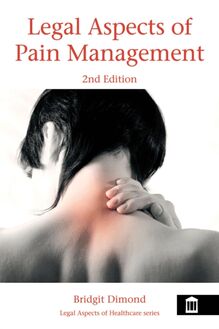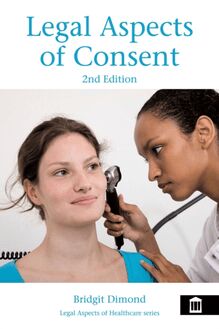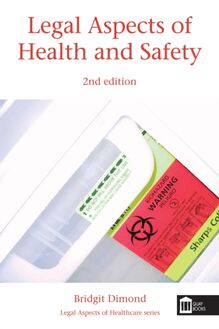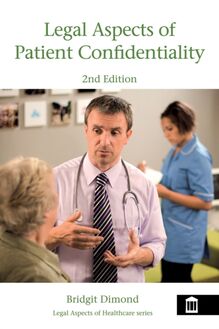Legal Aspects of Health and Safety , livre ebook
209
pages
English
Ebooks
2016
Vous pourrez modifier la taille du texte de cet ouvrage
Obtenez un accès à la bibliothèque pour le consulter en ligne En savoir plus
Découvre YouScribe et accède à tout notre catalogue !
Découvre YouScribe et accède à tout notre catalogue !
209
pages
English
Ebooks
2016
Vous pourrez modifier la taille du texte de cet ouvrage
Obtenez un accès à la bibliothèque pour le consulter en ligne En savoir plus
Publié par
Date de parution
27 juin 2016
Nombre de lectures
1
EAN13
9781856424646
Langue
English
Title Page
LEGAL ASPECTS OF HEALTH AND SAFETY
by
Bridgit Dimond
Publisher Information
Quay Books Division, MA Healthcare Ltd, St Jude’s Church, Dulwich Road, London SE24 0PB
Digital edition converted and distributed in 2013 by
Andrews UK Limited
www.andrewsuk.com
© MA Healthcare Limited 2011, 2013
All rights reserved. No part of this publication may be reproduced, stored in a retrieval system or transmitted in any form or by any means, electronic, mechanical, photocopying, recording or otherwise, without prior permission from the publishers
Edited by Jessica Anderson
Cover design by Louise Cowburn, Fonthill Creative
Associate Publisher: Thu Nguyen
Note
Healthcare practice and knowledge are constantly changing and developing as new research and treatments, changes in procedures, drugs and equipment become available.
The author and publishers have, as far as is possible, taken care to confirm that the information complies with the latest standards of practice and legislation.
Foreword to the 1 st Edition
Since the late 1990s, a systematic drive to improve the quality and safety of National Health Service care has been based, at its core, upon the concepts of risk management and clinical governance.
This book is a clear and comprehensive resource for healthcare professionals, setting out the relevant laws around these and a wide range of related issues.
Sir Liam Donaldson
Chief Medical Officer Department of Health
November, 2004
Preface to the 1 st Edition
Like the other books in this series, this text follows the publication of a series of articles in the British Journal of Nursing on health and safety law in health care. Those articles, revisited and updated, form the basis of a concise publication covering the main concerns which arise in the law relating to health and safety in the National Health Service.
This book is intended for all health professionals, health service managers, professional associations and trade unions, patient groups and their representatives. Each chapter uses a situation to illustrate the relevant laws so that the law can be explained in a practical jargon-free way. The basic facts of the legal system are briefly set out in the first chapter. The book does not pretend to be encyclopaedic in its coverage, rather it is intended to introduce readers to the basic principles which apply and the sources of law, so that they can, by following up the further reading and websites provided, add to their knowledge. Writing about health and safety law is like painting the bridge over the river Forth: it is never finished. Changes in the statutory provisions and new cases require some amendments, but hopefully this book will provide a baseline on which readers can develop their knowledge and understanding.
Bridgit Dimond
November, 2004
Preface to the 2 nd Edition
Seven years is a long time in legal history and it is not surprising that this second edition contains many changes from the first. Not only is there the usual updating of statutes and statutory instruments including the first prosecution under the Corporate Manslaughter and Homicide Act and new cases amending rulings set in previous cases, but there are new NHS organisations such as the Care Quality Commission. In addition the Coalition Government is taking a fundamental review of health and safety legislation in the light of the Young Report Common Sense Common Safety 2010. The Health and Safety Commission merged with the Health and Safety Executive into a single body and further changes are taking place with the abolition of many quangos including the National Patient Safety Agency. New guidance has been given in many of the specific areas covered including health surveillance, COSHH regulations, manual handling, violence, bullying and stress.
It is hoped that this concise book will continue to provide a foundation for an understanding of the laws relating to health and safety within the context of health and social care.
Bridgit Dimond
June 2011
Acknowledgements
I should like to acknowledge my sincere thanks to Binkie Mais, my editor of the first edition, for her industrious and meticulous work, to Jessica Anderson editor of this second edition who has continued to maintain the high standard set by Binkie and to Bette Griffiths who prepared all the indexes with her usual care and skill.
1: Introduction to the law
Scenario 1.1. Situation of ignorance
‘The law says:...’
Amanda, a clinical nurse practitioner in the Accident and Emergency (A&E) Department is surprised one day when she is told by a staff nurse, that the law says that all patients in A&E Departments should be seen by a doctor before they leave the Department. Amanda questions this statement but does not know how to find the answer.
Introduction
This chapter provides an introduction to the main sources of law and the legal system. The following topics will be covered: Sources of law Human Rights Act Other international charters relating to health and safety Civil and criminal law Civil and criminal courts Public and private law Legal personnel Procedure in the civil courts Procedure in the criminal courts Accusatorial system Law and ethics Rules of Professional Conduct
Sources of law
Law derives from two main sources: statute law and the common law.
Statute law
Statute law is based on legislation passed through the agreed constitutional process. Legislation in the UK is formed by the introduction of a bill into either the House of Lords or House of Commons, sometimes by the Government, sometimes by a private member and follows through a recognised procedure by way of hearings, committee stages and report stage and, eventually, following agreement by both Houses and the signature of the Queen, becomes an Act of Parliament. The actual date it comes into force will either be set out in the Act itself or will be determined at a later date by statutory instrument (known as secondary legislation). The Act of Parliament may provide for powers to be delegated to Ministers and others to enacting detailed rules to supplement the Acts of Parliament. These are known as Statutory Instruments. They must be placed before Parliament before coming into effect. Since devolution, the Scottish Parliament has the right to enact legislation, within specified parameters; the Welsh Assembly has more powers since the Referendum held in 2011. The main legislation on health and safety is the Health and Safety at Work Act 1974 under which many regulations have been made in the form of statutory instruments. Some of the regulations result from European Community Directives.
As a consequence of its signing of the Treaty of Rome, and becoming a member of the European Community (EC), the United Kingdom is bound by the legislation of the EC. The EC Regulations have direct application to member states, unlike the EC Directives which must be incorporated into UK law to be effective. (This does not apply to their application to State authorities, where they are automatically binding.)
Common law
Decisions by judges in courts create what is known as the common law, case law or judge-made law. A recognised hierarchy of the courts determines which previous decisions are binding on courts hearing similar cases. The European Court of Justice, which is held in Luxembourg, can hear cases between member states on European laws, or applications by the domestic courts for a ruling on a point of law. A recognised system of reporting of judges’ decisions ensures certainty over what was stated and the facts of the cases. The main principles that are set out in a case are known as the ratio decidendi (reasons for the decision). Other parts of a judge’s speech, which are not considered to be part of the ratio decidendi , are known as obiter dicta (things said by the way). Only the ratio decidendi is directly binding on lower courts, but the obiter dicta may influence the decision of judges in later court cases. It may be possible for judges to ‘distinguish’ previous cases and not follow them on the grounds that the facts are significantly different. For example, before the Occupier’s Liability Act 1984 was passed, which defined the liability of the occupier towards trespassers, the liability of the occupier to trespassers was based on decisions made by judges in disputes. Cases which involved harm to children where the occupier had been held liable, were held not to be binding on judges hearing cases involving adults, so that the occupier was held not to be liable to an adult trespasser. The earlier cases relating to children were ‘distinguished’. Subsequently, legislation relating to the occupier’s liability for trespassers was enacted in the Occupiers’ Liability Act 1984 ( Chapter 9 ).
Judges are, however, bound by statutes and if the result is an unsatisfactory situation, then this may be remedied by new amending legislation. If disputes in relation to the interpretation of the legislation arise, and the dispute is brought to court, then the specific section of the statute or paragraph of a statutory instrument has to be interpreted by the judge who will make a ruling. The decision may be appealed against by the party who has lost the case and eventually the Supreme Court may be called upon to make a decision. These decisions of the courts are known as precedents. Thus, law develops through a mix of statutory promulgation and common law decision making. The Human Rights Act 1998 (see below) takes precedence over other legislation, since a judge can make a declaration of incompatibility and can ref



